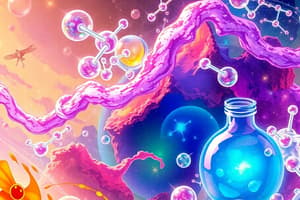Podcast
Questions and Answers
What are pure substances made up of?
What are pure substances made up of?
- Only gases
- One kind of matter (correct)
- Two or more kinds of matter
- Only solids
Pure substances can be either:
Pure substances can be either:
- A and B (correct)
- Mixtures
- Elements
- Compounds
What is an element?
What is an element?
An element is a substance that cannot be broken down into any simpler substance by chemical means.
What is a compound?
What is a compound?
What are mixtures?
What are mixtures?
What are the three types of mixtures?
What are the three types of mixtures?
A heterogeneous mixture is one where you can see the different parts.
A heterogeneous mixture is one where you can see the different parts.
A homogeneous mixture has visibly different components.
A homogeneous mixture has visibly different components.
Give an example of a mechanical mixture.
Give an example of a mechanical mixture.
What are suspensions?
What are suspensions?
What characterizes solutions?
What characterizes solutions?
All matter can be classified as either a pure substance or a mixture.
All matter can be classified as either a pure substance or a mixture.
Flashcards are hidden until you start studying
Study Notes
Pure Substances
- Composed of only one kind of matter without any mix.
- Can be categorized as elements or compounds.
Elements
- Defined as substances that cannot be chemically broken down into simpler substances.
- Consist of only one type of atom.
- Examples include iron (Fe) and silver (Ag).
Compounds
- Formed from two or more elements that are chemically combined.
- Represented by chemical formulas; for example, water (H₂O) consists of hydrogen and oxygen, while sugar (C₁₂H₂₁O₁₁) contains carbon, hydrogen, and oxygen.
- Classified as pure substances.
Mixtures
- Combinations of pure substances that do not chemically bond.
- Three types of mixtures exist, distinguished by visibility of components.
Types of Mixtures
- Mechanical Mixtures: Can physically see the different substances within the mixture, examples include soil and chocolate chip cookies.
- Suspensions: Cloudy mixtures where tiny particles of one substance are held within another liquid. Examples include tomato juice and shaken salad dressing, classified as heterogeneous mixtures.
- Solutions: Mixtures where the components are not visible and one substance is dissolved into another, resulting in a homogeneous mixture. Examples include tea, sugar in coffee, and vinegar (acetic acid in water).
Mixture Classifications
- Mixtures can be heterogeneous, where different parts are visible, or homogeneous, where all parts appear uniform.
- "Hetero" indicates difference, while "homo" indicates sameness in appearance.
Studying That Suits You
Use AI to generate personalized quizzes and flashcards to suit your learning preferences.




